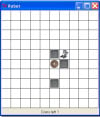hi guys, I have an assignment that is due on december first and i cant seem to get a wrap around it and was wondering if someone could help. I have been given a Robot module with 17 testboards and some predefined functions such as sensor, move, currentPosition, boardSize and so on and i have to come up with an algorithm and code to make it go around the board picking up the "coins" while avoidingthe "blocks" and without falling off the "edge". the link to the assignment is: http://www.cs.sfu.ca/CC/120/ggbaker/assign-1067/assign4 and the link to the robot module is http://www.cs.sfu.ca/CC/120/ggbaker/assign-1067/assign4-robot . if anyone has anyideas or could help that would be great. thanks
nnobakht 0 Light Poster
Recommended Answers
Jump to PostInteresting project, I will play with it!
Just curious, is this a computer science course? Hard to digest, since most CS departments are bastions of conservative stuff like C++ and Java. Engineering and Science departments luckily have been more pragmatic and open to using Python.
Jump to PostIf with 'simple' you mean 'not unnecessarily complex', I agree. Python is in many ways more powerfull than C++ or Java. Learning Python first might lead to a lot of pissing and moaning by the students who have to confront the often silly complexities of these other languages later. Well, …
All 8 Replies
Ene Uran 638 Posting Virtuoso
nnobakht 0 Light Poster
Ene Uran 638 Posting Virtuoso
nnobakht 0 Light Poster
nnobakht 0 Light Poster
Ene Uran 638 Posting Virtuoso

Mouche
nnobakht 0 Light Poster
Be a part of the DaniWeb community
We're a friendly, industry-focused community of developers, IT pros, digital marketers, and technology enthusiasts meeting, networking, learning, and sharing knowledge.
